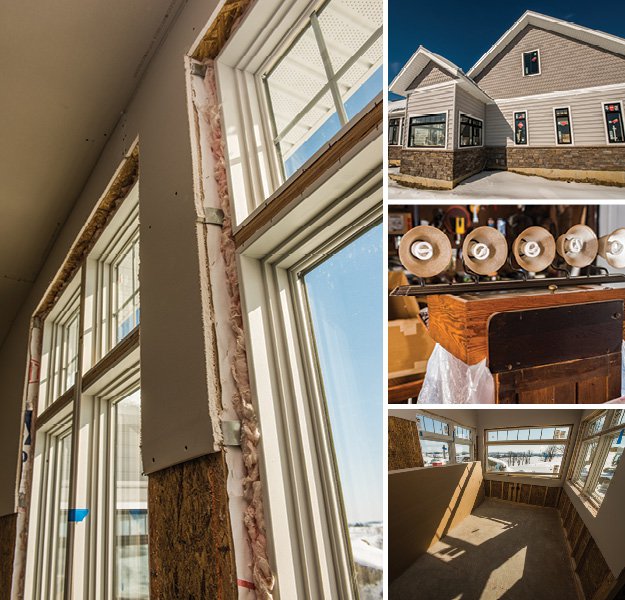Like a diary penned by a teenager in love, Kurt Reinhart’s blog ourpassivesolarhome.com is rife with intimate details about the construction of his custom-built solar home.
It is a digital record of what started out as a dream. The idea of building green incubated inside Kurt’s head for at least six years before coming to fruition last year.
GO SOLAR
Kurt and his wife, Joanne, moved from Maine back to Pennsylvania three years ago after a 33-year absence from the area to be closer to their grandchildren and two grown sons: Todd, who lives in Brooklyn, NY; and Joseph, who is from Souderton. The couple originally lived in New London, PA, in a restored 1740 log home.
Their interest in building new stemmed from costs associated with heating their 1870 sea captain’s house, which was consuming more oil in a week than its 275-gallon oil tank could hold. One year it cost more than $5,000 for fuel, and oil prices were expected to double. It was that kind of waste that led Kurt to start thinking about solar design strategies. “I just decided there had to be a better way,” he says. So the search began for alternative energy options. They were drawn to Net Zero Homes — buildings that produce as much energy as they consume. After touring one at an open house, it wasn’t long before Kurt began designing floor plans based on his research on his home computer.
LOCATION, LOCATION
The search started five states away in their hometown before the couple decided that finding the right plot of land required an actual visit to Berks County. They sold their historic home and temporarily relocated to Mohrsville with their Golden Retriever, Molly, in tow.
It took about a year to find the perfect site with the perfect amount of southern exposure. “I knew as soon as I walked up to the top of the hill on the property that it was the one,” says Kurt, who had been working with local realtor Jennifer Bryan, who specializes in building green and who was able to help narrow down the search.
SHOW ME THE SUN
The Reinharts' home — located about two miles south of Hamburg — is orientated 15 degrees east of true south. Its precise placement will warm up a nook near the kitchen and lend Kurt and Joanne a cozy area to have their coffee first thing in the morning. “It also provides a great view of the countryside,” Kurt shares.
To maximize the sun’s energy, 20 solar panels on the roof will help generate electricity, says Jeff Rhoads, business development manager at RMK Solar, the company responsible for doing the work.
According to Jeff, the panels will produce 6200 kilowatt hours of electricity per year. (RMK was able to calculate the power output of the system based on factors which included panel orientation, tilt and system size.)
Jeff estimates that in time the panels will offset approximately 80 to 100 percent of the Reinhart’s annual electricity usage.
As far as maintenance goes, the Reinharts will need periodic inspections of the system’s primary electrical components. “This should be done every couple of years,” advises Jeff. The panels are monitored by RMK through web-enabled data logging that automatically sends an email alert in the event of a problem.
ZERO CARBON FOOT PRINT
From windows and doors to attics and walls, the most cost-effective way to reduce heating and cooling bills is to air seal and insulate areas known to be problematic in your home. And it’s much easier to prevent air leaks than it is to try to find them — hence the Reinharts’ building from scratch despite Joanne’s love of historical homes.
A major source of air and water leakage, according to Kurt, takes places under the sill plate (the horizontal board that rests on top of the foundation wall). To air seal the area, a waterproof, rubber gasket can be used to seal the two together. The process, including drawings of the footer, foundation wall and sill gasket, is described in detail in Reinhart’s blog.
To further minimize air movement in and out of the house, structural insulated panels with an R-40 value (the “R” stands for resistance) ensure air tightness. “It’s basically like the whole home is wearing a jacket,” shares Reinhart’s builder Marco Folino of Folino Homes Inc., a certified green builder with the National Association of Home Builders (NAHB).

A CLOSER LOOK INSIDE
The Reinharts’ 2,100-plus-square-foot home has an attached two-car garage and wood shop. All primary rooms are on the first floor with two guest bedrooms and a bath on the second floor.
Their Craftsman-style house, still under construction, should be complete by early spring. When it is time to move in, Kurt and Joanne will be using repurposed and vintage items as much as possible. For instance, instead of traditional kitchen cabinets and countertops, they will be using three old Hoosier cabinets, each of which comes with its own porcelain work surface. This approach saved the couple approximately $17,000 as opposed to buying new. Also a 75-inch-long shelving wall unit will be used for storing dishes, cups and glasses. The unit, which cost only $300, saved the couple an additional $15,000, give or take.
In addition, they purchased an old cast iron porcelain sink for the kitchen and an older walnut shelving unit for additional storage space, shares Joanne.
Other good finds mentioned include two French doors, a pantry unit, several book cases and a wall locker unit purchased at an auction. The locker unit will be used to organize a mud room area off the garage.
All kitchen appliances are Energy Star-rated and an ozone water purification system for doing laundry will help keep detergent out of the septic system and hopefully eliminate the need for detergents altogether.
From both green and practical considerations, the couple plans to have a small lawn, probably less than a half-acre around the immediate house, says Kurt. The other seven acres will get brush-hogged in the summer. The couple intends to garden and compost, and they may even get into keeping some small animal livestock, they say.
THE GREEN TEAM ADVANTAGE
Kurt and Joanne knew that there would be many features to their new home that most builders would not be familiar with. “I didn't want a builder that was going to fight me on every feature,” Kurt shares. “But as soon as Marco told us he was interested in green construction and we saw his excitement about working with us, we knew he was the one.”
Marco’s wife, Andrea, a sales representative for the company and owner of Tendenza Fashion & Interiors, offers decorating and design skills as a courtesy to clients who put their faith in all new Folino home constructions.
She shares, “When building a green home that requires this much detail and focus, it’s important to communicate with the client. We encouraged them to visit the job site often and look at it as a team effort.”
Whether it’s for financial gain or saving the environment, no matter how you look at it, energy conservation is a win-win situation. Perhaps it’s Kurt who best describes the technical and emotional aspect of building a one-of-a-kind passive solar home in his blog. “A husband and wife team — on a mission to save the world, one house at a time.”
CONTACT INFORMATION Folino Homes Inc. 100 Anna Ave., Blandon 484.575.8352 | folinohomes.com Andrea Folino, CID, HSR Certified Tendenza Fashion & Interiors P: 484.575.8370 | F: 484.575.9903 TendenzaFI.com FashionableInteriors.blogspot.com RMK Solar 625 Spring St., Ste. 250, Reading 610.374.1108 | Rmksolar.com
Like a diary penned by a teenager in love, Kurt Reinhart’s blog ourpassivesolarhome.com is rife with intimate details about the construction of his custom-built solar home.
It is a digital record of what started out as a dream. The idea of building green incubated inside Kurt’s head for at least six years before coming to fruition last year.
GO SOLAR
Kurt and his wife, Joanne, moved from Maine back to Pennsylvania three years ago after a 33-year absence from the area to be closer to their grandchildren and two grown sons: Todd, who lives in Brooklyn, NY; and Joseph, who is from Souderton. The couple originally lived in New London, PA, in a restored 1740 log home.
Their interest in building new stemmed from costs associated with heating their 1870 sea captain’s house, which was consuming more oil in a week than its 275-gallon oil tank could hold. One year it cost more than $5,000 for fuel, and oil prices were expected to double. It was that kind of waste that led Kurt to start thinking about solar design strategies. “I just decided there had to be a better way,” he says. So the search began for alternative energy options. They were drawn to Net Zero Homes — buildings that produce as much energy as they consume. After touring one at an open house, it wasn’t long before Kurt began designing floor plans based on his research on his home computer.
LOCATION, LOCATION
The search started five states away in their hometown before the couple decided that finding the right plot of land required an actual visit to Berks County. They sold their historic home and temporarily relocated to Mohrsville with their Golden Retriever, Molly, in tow.
It took about a year to find the perfect site with the perfect amount of southern exposure. “I knew as soon as I walked up to the top of the hill on the property that it was the one,” says Kurt, who had been working with local realtor Jennifer Bryan, who specializes in building green and who was able to help narrow down the search.
SHOW ME THE SUN
The Reinharts' home — located about two miles south of Hamburg — is orientated 15 degrees east of true south. Its precise placement will warm up a nook near the kitchen and lend Kurt and Joanne a cozy area to have their coffee first thing in the morning. “It also provides a great view of the countryside,” Kurt shares.
To maximize the sun’s energy, 20 solar panels on the roof will help generate electricity, says Jeff Rhoads, business development manager at RMK Solar, the company responsible for doing the work.
According to Jeff, the panels will produce 6200 kilowatt hours of electricity per year. (RMK was able to calculate the power output of the system based on factors which included panel orientation, tilt and system size.)
Jeff estimates that in time the panels will offset approximately 80 to 100 percent of the Reinhart’s annual electricity usage.
As far as maintenance goes, the Reinharts will need periodic inspections of the system’s primary electrical components. “This should be done every couple of years,” advises Jeff. The panels are monitored by RMK through web-enabled data logging that automatically sends an email alert in the event of a problem.
ZERO CARBON FOOT PRINT
From windows and doors to attics and walls, the most cost-effective way to reduce heating and cooling bills is to air seal and insulate areas known to be problematic in your home. And it’s much easier to prevent air leaks than it is to try to find them — hence the Reinharts’ building from scratch despite Joanne’s love of historical homes.
A major source of air and water leakage, according to Kurt, takes places under the sill plate (the horizontal board that rests on top of the foundation wall). To air seal the area, a waterproof, rubber gasket can be used to seal the two together. The process, including drawings of the footer, foundation wall and sill gasket, is described in detail in Reinhart’s blog.
To further minimize air movement in and out of the house, structural insulated panels with an R-40 value (the “R” stands for resistance) ensure air tightness. “It’s basically like the whole home is wearing a jacket,” shares Reinhart’s builder Marco Folino of Folino Homes Inc., a certified green builder with the National Association of Home Builders (NAHB).

A CLOSER LOOK INSIDE
The Reinharts’ 2,100-plus-square-foot home has an attached two-car garage and wood shop. All primary rooms are on the first floor with two guest bedrooms and a bath on the second floor.
Their Craftsman-style house, still under construction, should be complete by early spring. When it is time to move in, Kurt and Joanne will be using repurposed and vintage items as much as possible. For instance, instead of traditional kitchen cabinets and countertops, they will be using three old Hoosier cabinets, each of which comes with its own porcelain work surface. This approach saved the couple approximately $17,000 as opposed to buying new. Also a 75-inch-long shelving wall unit will be used for storing dishes, cups and glasses. The unit, which cost only $300, saved the couple an additional $15,000, give or take.
In addition, they purchased an old cast iron porcelain sink for the kitchen and an older walnut shelving unit for additional storage space, shares Joanne.
Other good finds mentioned include two French doors, a pantry unit, several book cases and a wall locker unit purchased at an auction. The locker unit will be used to organize a mud room area off the garage.
All kitchen appliances are Energy Star-rated and an ozone water purification system for doing laundry will help keep detergent out of the septic system and hopefully eliminate the need for detergents altogether.
From both green and practical considerations, the couple plans to have a small lawn, probably less than a half-acre around the immediate house, says Kurt. The other seven acres will get brush-hogged in the summer. The couple intends to garden and compost, and they may even get into keeping some small animal livestock, they say.
THE GREEN TEAM ADVANTAGE
Kurt and Joanne knew that there would be many features to their new home that most builders would not be familiar with. “I didn't want a builder that was going to fight me on every feature,” Kurt shares. “But as soon as Marco told us he was interested in green construction and we saw his excitement about working with us, we knew he was the one.”
Marco’s wife, Andrea, a sales representative for the company and owner of Tendenza Fashion & Interiors, offers decorating and design skills as a courtesy to clients who put their faith in all new Folino home constructions.
She shares, “When building a green home that requires this much detail and focus, it’s important to communicate with the client. We encouraged them to visit the job site often and look at it as a team effort.”
Whether it’s for financial gain or saving the environment, no matter how you look at it, energy conservation is a win-win situation. Perhaps it’s Kurt who best describes the technical and emotional aspect of building a one-of-a-kind passive solar home in his blog. “A husband and wife team — on a mission to save the world, one house at a time.”
CONTACT INFORMATION Folino Homes Inc. 100 Anna Ave., Blandon 484.575.8352 | folinohomes.com Andrea Folino, CID, HSR Certified Tendenza Fashion & Interiors P: 484.575.8370 | F: 484.575.9903 TendenzaFI.com FashionableInteriors.blogspot.com RMK Solar 625 Spring St., Ste. 250, Reading 610.374.1108 | Rmksolar.com
by Marcia Weidner-Sutphen | photos by John A. Secoges, Secoges Photographics
















